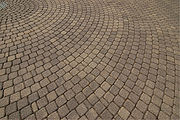
Concrete paver blocks in a circular pattern

Concrete paver blocks in a rectangular pattern
An interlocking concrete paver is a pre-cast piece of concrete or brick commonly used in exterior hardscaping applications. Developed in Europe and introduced into the United States in the early 1970s, interlocking concrete paving stones is an alternative to plain concrete or asphalt.
Installed over a compacted stone sub-base and a leveling bed of sand, concrete paving stones can be used for walkways, patios, pool decks and driveways and airport or loading docks.
Pressing the dry concrete-mix into moulds rather than pouring a wetter mix allows for their 8000 psi compressive strength, making concrete paving stones a more durable choice than clay bricks or poured-in-place concrete. Clay pavers have an advantage with resistance to fading from the sun and deterioration from long term exposure to the elements. They also do not require a seal coat to prevent staining, unlike the concrete paver. Because clay pavers are fired, the pores of the paver are closed, therefore creating an almost non permeable surface. A main disadvantage is color spectrum. They are a natural material so colors are limited. Concrete on the other hand has a limitless color spectrum when using white portland cement and pigments.
Interlocking pavers are available in a wide range of shapes. For instance, a diagonal arrangement of rectangular tiles might create a herringbone pattern. Hexagons fit tightly together.
Instead of connecting the pavers by pouring grout between the joints, as one would with tiles, sand particles are spread over the pavers and tamped down. The sand stabilizes the interlocking pavers, yet allows for some flexibility. In other words, this type of pavement can absorb stress such as small earthquakes, freezes and thaws, and slight ground erosion by shifting each tile slightly. Therefore, they will not crack or buckle like concrete.

Brick paving being laid on a sand base, in south west England
Installing[]
The mere special tools needed for installing interlocking pavers are vibrating compaction machine or "vibra plate" and shear cutter. The former is used to compact the base material to 90% density minimum and also to set and interlock the pavers into the sand bed. The latter is used to cut the pieces to fit at corners and edges. The sand does not easily wash out with rain or garden hose water and a sealer can be spread on to further lock the sand.
A driveway benefits from a sealer so that oil and tire marks will not stain. The sealer creates an invisible barrier on top of the pavers.
The next generation of paver is the permeable interlocking concrete paver where moisture filters through the joints down to a crushed rock base. This allows for ground water recharge and less stress on over taxed storm water systems during high rain conditions. Preparation and base material is not the same for this system as with a non-permeable concrete paver installation.
Standard thicknesses are 60mm (for light traffic) and 80mm (heavy traffic). 50mm too is common in some countries like Pakistan (used for footpaths etc).
Advantages[]
The benefits of paver over the asphalt and poured concrete are high compressive strengths (7000+psi as per BS and 8000+psi as per ASTM codes), pleasant look, time saving, easy removal and relaying etc.
In the US, pavers are becoming more and more popular. The benefits of paving stones over concrete driveways are significant. For example, these are the characteristics and advantages of pavers: [1]
- Paving Stones Increase Property Value
- Pavers Are 4x Stronger Than Concrete
- Paving Stones Are Earthquake Resistant
- Paving Stones Are Cheaper To Repair
- Better Weight Distribution
- Stones Have Elegance and Beauty
Disadvantages[]
Disadvantages and drawbacks of concrete:
- Cracked Concrete Driveways Lower Home Value
- Concrete Strength Is Inferior to Paving Stones
- Concrete Often Cracks During Earthquakes
- Can't Repair Concrete Without Ugly Scarring
- Does Not Flex Well Under Stress
- Bland And Dull-Looking Driveways
- Concrete Will Cost You More In The Long-Run
Notes[]
- ↑ Pavers Expert http://www.paversexpert.com
External links[]
This page is being imported from Wikipedia, to create a Wikidwelling stub or article. These steps need to be completed:
The original article was at Paver (flooring). The list of authors can be seen in the history for that page. The text of Wikipedia is available under the CC-BY-SA 3.0 license. |
